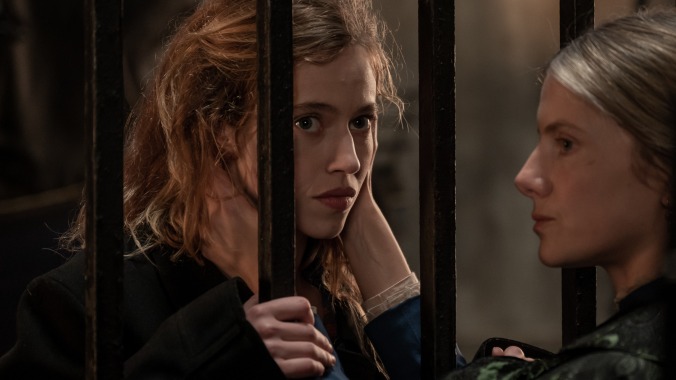The Mad Women's Ball brings a dark chapter in medical history to lavish life
Mélanie Laurent directs this fiery feminist tale set in a 19th-century French asylum


The ancient Greek physician Hippocrates was the first person to use the word “hysteria” to describe a psychological condition believed to be unique to women, which he postulated came from a “wandering uterus” caused by “stagnant humors” resulting from a lack of regular sexual intercourse. In the 18th century, the locus of hysteria was moved upwards from the uterus to the brain. Hysteria wasn’t eliminated from the DSM until 1980, but had its heyday in the repressed Victorian era, when any signs that a (white, upper-class) woman was rebellious, melancholy, or otherwise dissatisfied with her “proper place” meant that she could be shipped off to an asylum to be “cured.”
Eugénie (Lou de Laâge), the heroine of The Mad Women’s Ball, is one such woman. Eugénie’s troubles are twofold. First, she expects to have the same freedoms as her brother, Théo (Benjamin Voisin), and has the audacity to speak her mind on the matter in mixed company. The second is a bit more esoteric: She has the ability to see and hear the dead. This initially complicates the story, as Eugénie’s visions could be a symptom of a genuine psychiatric illness. But soon enough, her powers are proven to be real. They then recede into the background as she’s betrayed by her father and brother and committed to the infamous La Pitié Salpêtrière, a Parisian hospital that was, at the time, the preferred dumping ground for mouthy daughters of the French aristocracy.
There, she’s subjected to torture under the pretense of therapy, including baths in ice-cold water that leave her blue and shaking. Another patient, the sweet, trusting, and deeply traumatized Louise (Lomane de Dietrich), is trotted out for hypnosis demonstrations where she’s made to seize and urinate on herself in front of crowds of serious gentlemen in dark suits. Director Mélanie Laurent, the French movie-star-turned-filmmaker who made Breathe and Galveston, doesn’t skimp on the barbarous details of how patients were “treated” in La Pitié Salpêtrière. She paints its chief neurologist, a real-life figure named Dr. Charcot (Grégoire Bonnet), as a callous misogynist who views his patients as less than human. In this way, The Mad Women’s Ball is a fiery diatribe against medical sexism, an issue that presents differently in the 21st century than it did in the 19th but is still very much with us.
Laurent also co-stars as Geneviève, a nurse at La Pitié Salpêtrière who strikes up a friendship with Eugénie and who represents a different side of patriarchal control. In another age, Geneviève would have become a doctor herself. But as is she’s stuck in a subordinate role where her day-to-day observations are ignored in favor of the high-minded (but completely off base) theories of capital-G Great Men. Geneviève starts out as the Nurse Ratched of the piece, but as the narrative progresses, it becomes clear that she and Eugénie are both free birds rattling the same cage. All this builds towards the eponymous ball, an annual event where the patients of La Pitié Salpêtrière are paraded in a grotesque spectacle, public invited to come gawk at madwomen.
In terms of storytelling, The Mad Women’s Ball is straightforward, presenting a clear linear narrative that follows the trajectory of Victoria Mas’ source novel. The feminism of the piece is also straightforward—one might even say simplistic—with the male doctors painted as monsters and the female patients as victims. Laurent reveals the mechanisms of control that were used to keep women weak and obedient during this time period, at one point crosscutting between the lacing of a corset and sadistic psychiatric “cures.” She also emphasizes the camaraderie between the women imprisoned at La Pitié Salpêtrière, and shows a genuine affection for the patients as they go about their days as best they can.
The period detail is ambitious and lavish, the film opening with throngs of mourners at Victor Hugo’s funeral in 1885 (naturally, the romantically minded Eugénie is in attendance) and culminating with a tattered variation on the fancy-dress ball. The asylum is convincingly rendered as well, Laurent adding dramatic chiaroscuro lighting to spare dormitories and forbidding stone cells. This is a work of feminist melodrama, one that uses real events as a backdrop for a romantic, woman-centric tale of rebellious spirits and dreams deferred. As such, it might not be the most nuanced portrayal of this particular chapter in history. But it is passionate, fathers and doctors be damned.